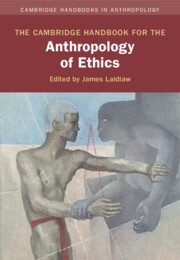Book contents
- The Cambridge Handbook for the Anthropology of Ethics
- Cambridge Handbooks in Anthropology
- The Cambridge Handbook for the Anthropology of Ethics
- Copyright page
- Contents
- Contributors
- 1 Introduction
- Part I Intellectual Sources and Disciplinary Engagements
- Part II Aspects of Ethical Agency
- Part III Media and Modes of Ethical Practice
- Part IV Intimate and Everyday Life
- Part V Institutional Life
- 29 Modern Capitalism and Ethical Plurality
- 30 The Ethics of Commerce and Trade
- 31 Activism and Political Organization
- 32 Philanthropy
- 33 Science
- 34 Communist Morality under Socialism
- Index
- References
33 - Science
The Anthropology of Science As an Anthropology of Ethics (and Vice Versa)
from Part V - Institutional Life
Published online by Cambridge University Press: 11 May 2023
- The Cambridge Handbook for the Anthropology of Ethics
- Cambridge Handbooks in Anthropology
- The Cambridge Handbook for the Anthropology of Ethics
- Copyright page
- Contents
- Contributors
- 1 Introduction
- Part I Intellectual Sources and Disciplinary Engagements
- Part II Aspects of Ethical Agency
- Part III Media and Modes of Ethical Practice
- Part IV Intimate and Everyday Life
- Part V Institutional Life
- 29 Modern Capitalism and Ethical Plurality
- 30 The Ethics of Commerce and Trade
- 31 Activism and Political Organization
- 32 Philanthropy
- 33 Science
- 34 Communist Morality under Socialism
- Index
- References
Summary
Ethical self-formation and epistemic virtues have been a focus of attention in the history of science for over three decades, and yet, despite some important early contributions, anthropologists of science have only recently started to pay more sustained and explicit attention to the ethical. This chapter argues that anthropologists of science could benefit from taking a closer and more systematic look at recent developments in the anthropology of ethics. Conversely it suggests that anthropologists of ethics might gain from a closer consideration of some of the specificities of Euro-American science as an (internally and externally contested, multiple, and perhaps in part fictitious) ethical tradition. The first half of the chapter explores the rather fitful genealogy of an interest in the ethical in the history, sociology, and anthropology of science, and points to some of the elements from which the anthropology of science as an anthropology of ethics might be (re)built. The second half of the chapter gives one extended, ethnographically grounded example of what such a (re)building might produce, and suggests some of the ways in which anthropology’s exploration of both science and ethics might benefit.
- Type
- Chapter
- Information
- The Cambridge Handbook for the Anthropology of Ethics , pp. 839 - 870Publisher: Cambridge University PressPrint publication year: 2023
References
- 16
- Cited by



